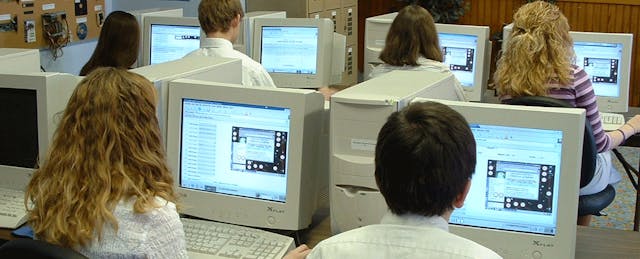Ten years ago, I began my teaching journey into the angst-filled pre-teen lives of 5th graders. In the midst of lessons on U.S. government, algebra, and cause and effect, I found a great motivator and equalizer in the three outdated computers tucked quietly into the corner of my classroom. Those delicately wired devices, enhanced with only a noisy, dot matrix printer, served as a window to the world for my class of 22 students in a rural West Virginia school. They took turns creating graphs and charts for science experiments and math units. We found a classroom to be pen pals with in Seoul, South Korea. There were games and Web 2.0 (still in its early stages) that not only encouraged my students to create but gave them valuable reinforcement of the skills learned in class. This wondrous outstretched hand known as the Internet enhanced my lessons and served as a springboard to inspire not only my students’ creativity in the classroom, but also my own.
Fast forward a decade. Those three dusty computers were replaced by a sleek set of desktops long ago, along with a set of 5 iPad Minis. In the ghost of my grimy chalkboard is a sleek, interactive whiteboard that can transport my entire class into another world with a touch of a finger. My students, although still facing the internal battles of the same 5th graders ten years ago, have iPods and cell phones jammed into their pockets and book bags. That slowly plodding Internet that I once used to gently introduce my classroom to the outside world is now a fast-paced superhighway of social media that can veer quickly into the danger zone. While pitfalls abound, the access to technology has never been greater, and student interest and technology knowledge it is at its zenith.
Virtual assessment seems like a logical first step for taking advantage of the power of devices and bandwidth. It makes sense: When you have students take tests online, the results are immediately calculated and available to analyze. If the assessment program says they’re weak in a particular area, assign this online practice for reinforcement. With such easy accessibility, we can have students take every assessment on a computer--think of the time saved on grading papers and calculating data!
Our computer labs, all three of them, are routinely filled with classes entering not only to do research and develop projects, but to take placement tests, pretests and standardized assessment practice. Nervous teachers, fearful of what a number on a printout says about their class’s progress, have their students practice using technological tools to build upon creativity and logical reasoning skills.
Then March roars into the school year like a lion. By this time in the year, my students have matured in their thinking and abilities in a way that allows me to challenge their thinking and give them control to explore and create examples of their learning. Only now, with standardized assessment completely online, the three computer labs at our school of over 600 third through fifth graders will be filled with students taking tests.
A computer lab constantly filled with standardized test takers is a sterile, high stakes environment devoid of discovery and curiosity. Cautious third graders, some with limited experience using technology, are now timidly navigating an online platform for an assessment that will serve as the hallmark of their progress that year. From March until the end of May, technology’s role is not facilitating exploration but processing results.
I think back to a decade ago, before assessment became unplugged. While I’m grateful for the ability to know in an instant how my students fare on a test or measure their learning using a predetermined value, classroom technology was not meant to be absorbed by the almighty test score.
We are risking driving a generation of students away from using the device in their pockets to learn, instead becoming disheartened and bored by what it means to “use the computer.” In an era of looking for progress in a number, we are failing to remember that it won’t matter what students can tell a machine if they don’t have the depth, warmth and excitement that comes from an innovative classroom environment.
Tests don’t build skills. Teachers do.


